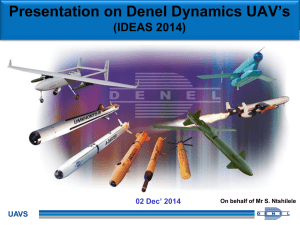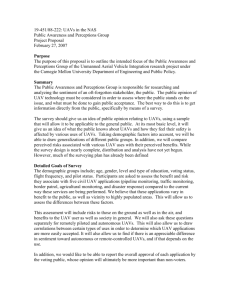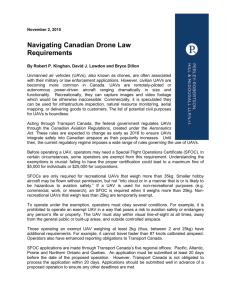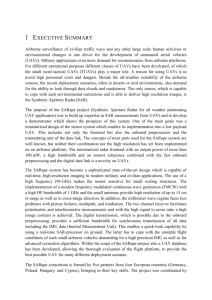INTRODUCTION CHAPTER 1
advertisement
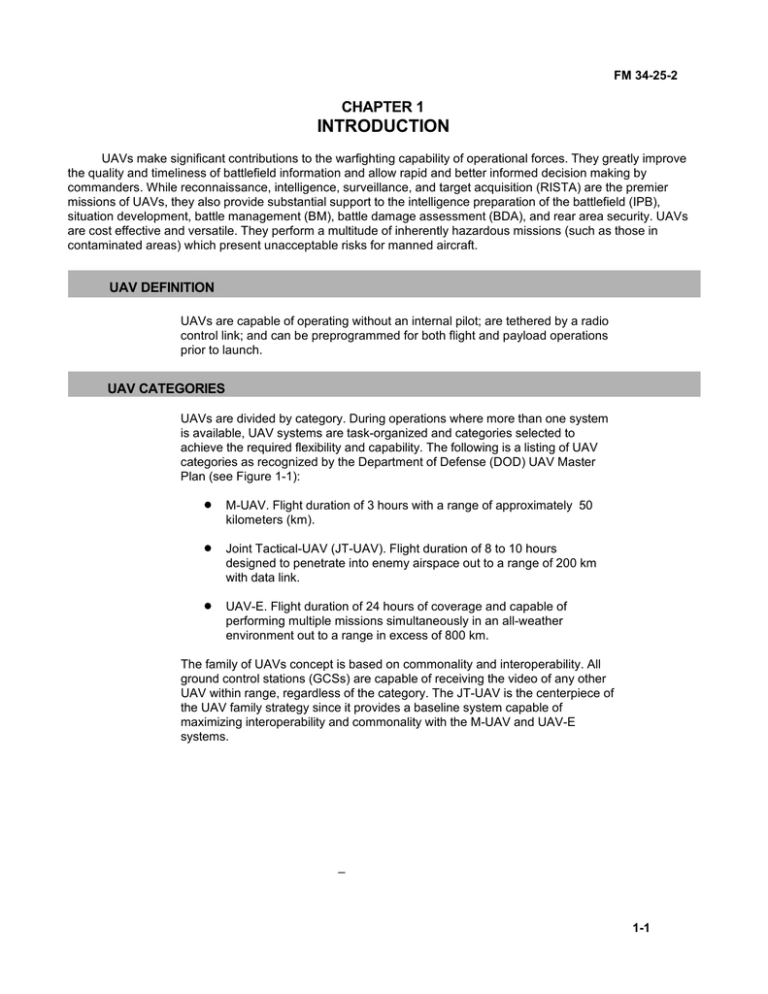
FM 34-25-2 CHAPTER 1 INTRODUCTION UAVs make significant contributions to the warfighting capability of operational forces. They greatly improve the quality and timeliness of battlefield information and allow rapid and better informed decision making by commanders. While reconnaissance, intelligence, surveillance, and target acquisition (RISTA) are the premier missions of UAVs, they also provide substantial support to the intelligence preparation of the battlefield (IPB), situation development, battle management (BM), battle damage assessment (BDA), and rear area security. UAVs are cost effective and versatile. They perform a multitude of inherently hazardous missions (such as those in contaminated areas) which present unacceptable risks for manned aircraft. UAV DEFINITION UAVs are capable of operating without an internal pilot; are tethered by a radio control link; and can be preprogrammed for both flight and payload operations prior to launch. UAV CATEGORIES UAVs are divided by category. During operations where more than one system is available, UAV systems are task-organized and categories selected to achieve the required flexibility and capability. The following is a listing of UAV categories as recognized by the Department of Defense (DOD) UAV Master Plan (see Figure 1-1): M-UAV. Flight duration of 3 hours with a range of approximately 50 kilometers (km). Joint Tactical-UAV (JT-UAV). Flight duration of 8 to 10 hours designed to penetrate into enemy airspace out to a range of 200 km with data link. UAV-E. Flight duration of 24 hours of coverage and capable of performing multiple missions simultaneously in an all-weather environment out to a range in excess of 800 km. The family of UAVs concept is based on commonality and interoperability. All ground control stations (GCSs) are capable of receiving the video of any other UAV within range, regardless of the category. The JT-UAV is the centerpiece of the UAV family strategy since it provides a baseline system capable of maximizing interoperability and commonality with the M-UAV and UAV-E systems. _ 1-1 FM 34-25-2 figure 1-1 (3.75") _ There are UAVs within the DOD inventory being used as an interim operational capability and as an aid to familiarize and develop doctrine and TTPs. Current systems include— The Pioneer system which carries day or night imagery intelligence (IMINT) payloads out to a range of 185 km for 4 hours of flight. The Pointer system which carries a day only IMINT payload out to 5 km for 1 hour of flight. The EXDRONE system which carries a day only IMINT payload out to a distance of 45 km for 2.5 hours of flight. UAV SUPPORT TO COMMANDERS UAVs make a significant contribution to warfighting. They greatly improve the quality, quantity, and timeliness of battlefield information and allow rapid and better informed decision making by battlefield commanders. UAVs are an integral part of the Intelligence Battlefield Operating System (BOS). 1-2 FM 34-25-2 Tactical commanders fight the enemy in an area of operation (AO) assigned to them. To anticipate enemy actions, they need to identify and monitor enemy activities within their AO and area of interest (AI). JOINT, COMBINED, AND INTERAGENCY OPERATIONS Most future operations involving the Army will be joint and multinational. The UAV will operate in an interagency environment alongside other government agencies like the State Department, the Federal Bureau of Investigation (FBI), and the Drug Enforcement Agency (DEA). UAV assets conduct the full range of military operations that integrate warfighting and OOTW. Because all branches of the service are involved in UAV development, they must have interoperable systems. For more information on interoperability, refer to Joint Pub 3-55.1. EMPLOYMENT UAVs will deploy worldwide in support of force projection operations. They will support their respective service component commander and when tasked, the Joint Forces Commander (JFC). UAVs are capable of being operated from outside the AO and perform missions related to specified areas of the battlefield during day and night, land, air, or maritime operations. Examples of employment for JT-UAV, M-UAV, and UAV-E are found in Figures 1-2, 1-3, and A-2, respectively. 1-2 (full) 1-3 FM 34-25-2 _ 1-4 FM 34-25-2 1-3 (4.50) _ MISSION The UAV unit conducts day and night operations to supported units. Missions include, but are not limited to— Support to route, area, and zone reconnaissance support. Surveillance of named areas of interest (NAIs). Support to combat search and rescue (SAR). Support to target acquisition. Adjusting indirect fire weapons, close air support (CAS), and close-in fire support (CIFS). Support to BDA. 1-5 FM 34-25-2 Support to rear area security. Support to situation development. Support to IPB. UAVs are especially valuable in environments where immediate information feedback is needed, manned aircraft are unavailable, or excessive risk or other conditions render use of manned aircraft less than prudent. With planned future growth, specified UAVs will also perform missions such as EW, communications relay, mine and chemical detection, and weather surveillance. UAV SUPPORT TO INTELLIGENCE The various mission payload packages (IMINT, signals intelligence (SIGINT), etc.) flown by the UAVs, provide near-real-time (NRT) data support to the six intelligence functions, also known as the intelligence mission essential task list (METL). These functions are defined in FM 34-1. Military intelligence (MI) executes its METL through a clearly defined set of tenets, the foremost being the commander drives the intelligence effort. Intelligence is valuable only if it satisfies the commander's planning and warfighting requirements in a timely manner. This can only be accomplished if the commander drives intelligence. UAVs underwrite the MI tenets by allowing the commander to see the battlefield and better control his assets. They will fly deep into the operational area and are flexible enough to be tactically tailored to provide relevant, timely, and accurate information when and where needed. UAVs also support and complement IPB and can focus on actions or events which are determined to be critical to the commander and his intelligence effort. The range and endurance of UAVs give the commander an unblinking eye (focused on the enemy) where and when he needs it, while minimizing risks to his resources. The UAV can be launched, recovered, and maintained from a consolidated location while dispersed supported units control its flight path and receive down-linked data and video. Intelligence organizations at each echelon process information collected by the UAV, and use it to complement collection from other sources. 1-6


